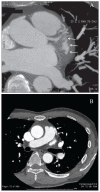A rare cause of exercise induced ventricular tachycardia
- PMID: 26409802
- PMCID: PMC6074464
- DOI: 10.5144/0256-4947.2015.257
A rare cause of exercise induced ventricular tachycardia
Abstract
Coronary fistulas are anomalous shunts from a coronary artery to a cardiac chamber or great vessel, bypassing the myocardial circulation. A 42-year-old Asian man with no significant history of cardiac disease presented with exertional chest discomfort in the form of chest tightness over the precordial area. The patient had no cardiac risk factors, but given the duration and persistence of symptoms, we did a stress echocardiogram. The exercise led to a 'coronary artery steal phenomenon' caused by the coronary fistula, which diverted the blood from the left anterior descending artery to the pulmonary artery thereby producing the ischemic symptoms and ventricular tachycardia. Transcatheter coil embolization was unsuccessful, but the fistula was eventually closed surgically. A repeat stress echocardiogram before discharge was completely normal. We emphasize the need to individualize treatment, taking into consideration all factors in a particular patient.
Figures
Similar articles
-
Exercise-induced ventricular tachycardia associated with coronary arteriovenous fistula and correction by transcatheter coil embolization.Catheter Cardiovasc Interv. 1999 Apr;46(4):470-2. doi: 10.1002/(SICI)1522-726X(199904)46:4<470::AID-CCD20>3.0.CO;2-1. Catheter Cardiovasc Interv. 1999. PMID: 10216020
-
Coronary artery fistula: an unusual cause of chest pain in a young adult.Catheter Cardiovasc Interv. 2012 Feb 1;79(2):312-4. doi: 10.1002/ccd.23091. Epub 2011 Nov 30. Catheter Cardiovasc Interv. 2012. PMID: 21538782
-
[Transcatheter embolization of ascending aorto-pulmonary fistula combined with coronary arteriovenous fistula].Kokyu To Junkan. 1993 Oct;41(10):1005-8. Kokyu To Junkan. 1993. PMID: 8235114 Japanese.
-
Coronary artery fistulas: clinical and therapeutic considerations.Int J Cardiol. 2006 Feb 8;107(1):7-10. doi: 10.1016/j.ijcard.2005.01.067. Epub 2005 Aug 24. Int J Cardiol. 2006. PMID: 16125261 Review.
-
[Chest pain syndrome in normal or non-diagnostic conventional ECG at the emergency service. Assessment with myocardial perfusion (SPECT) and ventricular function (Gated-SPECT)].Arch Cardiol Mex. 2004 Jan-Mar;74 Suppl 1:S18-31. Arch Cardiol Mex. 2004. PMID: 15216744 Review. Spanish.
References
-
- Ma ES, Yang ZG, Guo YK, Zhang XC, Sun JY, Wang RR. Clinical value of 64-slice CT angiography in detecting coronary artery anomalies. Sichuan Da Xue Xue Bao Yi Xue Ban. 2008 Nov;39(6):996–9. - PubMed
-
- Schroeder S, Achenbach S, Bengel F, Burgstahler C, Cademartiri F, De Feyter P, George R, Kaufmann P, Kopp AF, Knutti J, Ropers D, Schuijf J, Tops LF, Bax JJ. Cardiac Computed tomography: indications, applications, limitations and training requirements. EJH. 2008;29:531–556. - PubMed
Publication types
MeSH terms
LinkOut - more resources
Full Text Sources
Other Literature Sources
Medical



